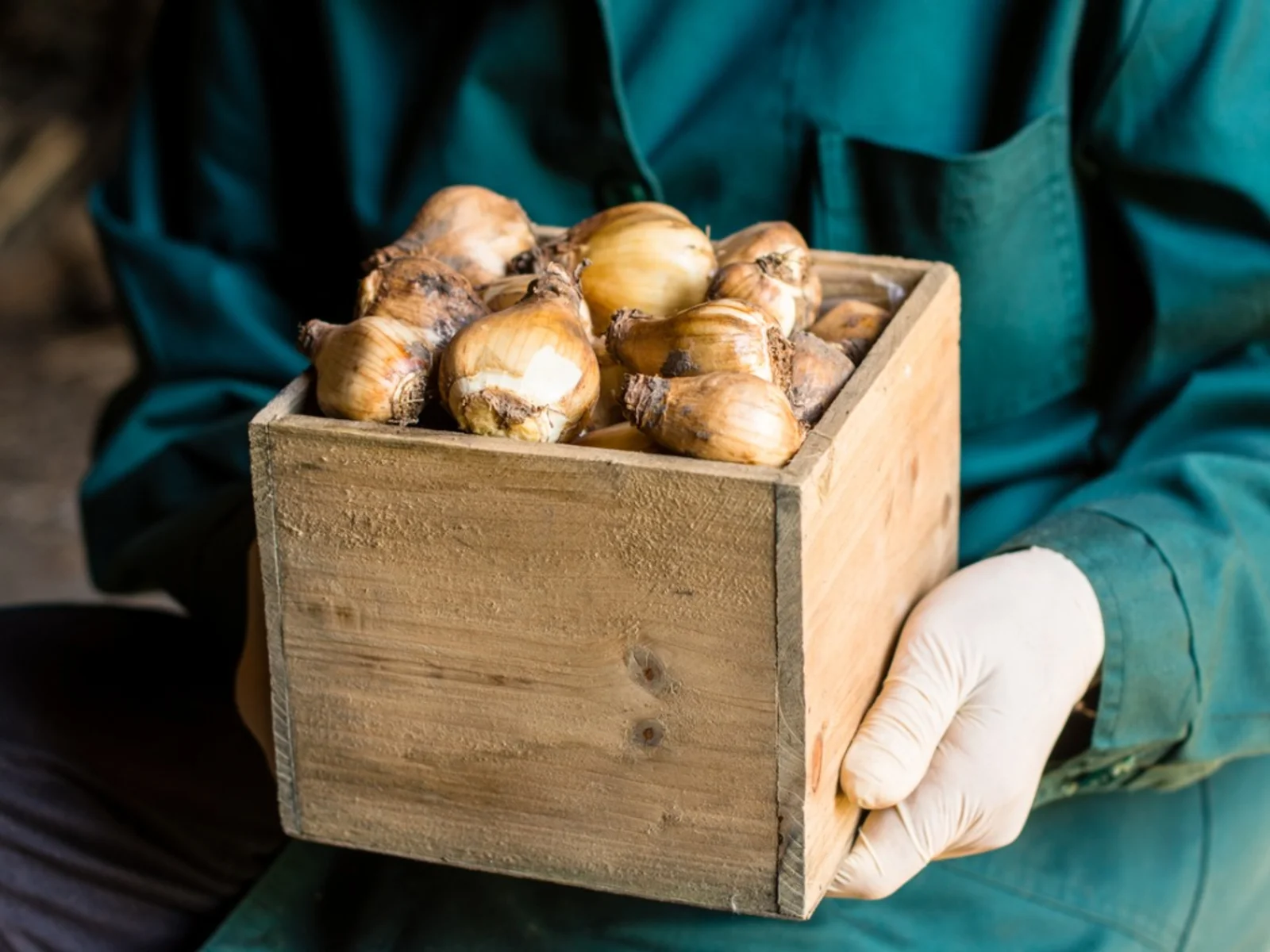Home>Types of Gardening>Ornamental Gardening>How Long Can Tulip Bulbs Be Stored In The Refrigerator


Ornamental Gardening
How Long Can Tulip Bulbs Be Stored In The Refrigerator
Modified: January 22, 2024
Discover how long tulip bulbs can be safely stored in the refrigerator for optimal results in your ornamental gardening endeavors. Learn the best practices for preserving tulip bulbs.
(Many of the links in this article redirect to a specific reviewed product. Your purchase of these products through affiliate links helps to generate commission for Chicagolandgardening.com, at no extra cost. Learn more)
Table of Contents
Introduction
How Long Can Tulip Bulbs Be Stored In The Refrigerator
Tulips are renowned for their vibrant and captivating blooms, adding a touch of elegance to gardens and indoor spaces. However, these stunning flowers have a life cycle that extends beyond their blossoming period, beginning with their bulbs. Tulip bulbs contain all the nutrients and genetic material necessary to produce the next generation of tulips. Proper storage of these bulbs is crucial to preserving their vitality and ensuring successful growth in the following season.
Storing tulip bulbs in the refrigerator is a common practice among gardeners and horticulture enthusiasts. This method allows for controlled conditions that mimic the bulbs' natural environment during the winter months, promoting their dormancy and preventing premature growth. However, the duration for which tulip bulbs can be effectively stored in the refrigerator depends on various factors, including the bulb's condition, the storage environment, and the specific requirements of the tulip variety.
Understanding the optimal storage duration for tulip bulbs is essential for maintaining their viability and maximizing their potential for future growth. In this comprehensive guide, we will explore the factors that influence tulip bulb storage, the best practices for refrigerating tulip bulbs, the ideal storage duration, and the signs of bulb deterioration. By delving into these aspects, gardeners can gain valuable insights into preserving the health and vigor of their tulip bulbs, ultimately contributing to the success of their gardening endeavors.
Factors Affecting Tulip Bulb Storage
Several key factors play a pivotal role in determining the success of tulip bulb storage. Understanding these variables is crucial for implementing effective storage practices and maintaining the bulbs’ viability. By considering the following factors, gardeners can optimize the storage conditions and enhance the likelihood of producing healthy and vibrant tulips in the subsequent growing season.
- Bulb Quality: The initial quality of the tulip bulbs significantly influences their storability. Bulbs that are firm, free from damage, and devoid of mold or disease are more likely to withstand extended periods of storage. It is essential to inspect the bulbs before storage, discarding any that show signs of decay or damage.
- Storage Environment: The storage environment plays a critical role in preserving the bulbs. Factors such as temperature, humidity, and ventilation can impact the bulbs’ condition. Ideally, tulip bulbs should be stored in a cool, dark, and well-ventilated area to inhibit premature sprouting and minimize the risk of fungal growth.
- Bulb Maturity: The stage of bulb maturity at the time of storage can influence its ability to withstand prolonged dormancy. Fully mature bulbs, characterized by well-developed scales and a solid feel, are generally more resilient during storage compared to immature or undersized bulbs.
- Pre-Storage Treatment: Prior to storage, bulbs can benefit from specific treatments aimed at fortifying their resilience. This may include dusting the bulbs with a fungicidal powder to prevent mold and disease, as well as allowing the bulbs to air dry to promote skin formation, which aids in preventing dehydration during storage.
- Bulb Variety: Different tulip varieties exhibit varying degrees of storability. Some varieties may naturally fare better in storage conditions, while others may require more precise environmental control to maintain their vitality. Understanding the specific requirements of the tulip variety being stored is essential for ensuring optimal storage outcomes.
By considering these factors and implementing appropriate measures, gardeners can significantly impact the success of tulip bulb storage, ultimately contributing to the overall health and vigor of their tulip plants in the subsequent growing season.
How to Store Tulip Bulbs in the Refrigerator
Storing tulip bulbs in the refrigerator is a strategic approach to preserving their vitality during the dormant period. By creating a controlled environment that mimics the bulbs’ natural winter conditions, gardeners can effectively extend the storage duration while safeguarding the bulbs from premature sprouting and decay. Here’s a step-by-step guide to storing tulip bulbs in the refrigerator:
- Prepare the Bulbs: Before storing, carefully inspect the tulip bulbs, discarding any that show signs of damage, disease, or rot. It is essential to ensure that the bulbs are clean and dry before proceeding with storage.
- Select Suitable Containers: Choose breathable containers such as mesh bags or paper bags to store the tulip bulbs. Avoid airtight containers, as they can trap excess moisture and compromise the bulbs’ condition.
- Provide Proper Labeling: Clearly label the containers with the tulip variety and the date of storage to facilitate easy identification when retrieving the bulbs for planting.
- Optimal Refrigerator Placement: Place the labeled containers of tulip bulbs in the refrigerator’s crisper drawer or a designated section with consistent cool temperatures. Avoid storing the bulbs near fruits or vegetables, as they release ethylene gas, which can negatively impact the bulbs.
- Maintain Stable Temperature: Aim to maintain a stable refrigerator temperature between 35-45°F (1.6-7.2°C) to promote dormancy without exposing the bulbs to freezing conditions.
- Regular Monitoring: Periodically check the stored bulbs for any signs of mold, decay, or sprouting. If any bulbs show indications of deterioration, remove them promptly to prevent the spread of issues to the remaining bulbs.
- Avoid Freezer Storage: Refrain from storing tulip bulbs in the freezer, as the extremely low temperatures can damage the bulbs and hinder their ability to sprout successfully in the following growing season.
By following these guidelines, gardeners can ensure that their tulip bulbs are stored in optimal conditions within the refrigerator, maximizing their potential for robust growth and vibrant blooms when the planting season arrives.
Ideal Storage Duration for Tulip Bulbs
Determining the ideal storage duration for tulip bulbs is essential for maintaining their viability and ensuring successful growth in subsequent seasons. While tulip bulbs are capable of prolonged dormancy, prolonged storage can diminish their vigor and impact their ability to produce healthy plants. The optimal storage duration for tulip bulbs largely depends on the specific variety, the bulbs’ initial condition, and the storage environment. Here are essential considerations for determining the ideal storage duration:
- Variety-Specific Requirements: Different tulip varieties exhibit varying dormancy periods, with some requiring longer storage to mimic their natural environmental cues. It is crucial to research the specific storage needs of the tulip variety being cultivated to align with its natural growth cycle.
- Bulb Condition at Harvest: The initial condition of the harvested bulbs influences their capacity for extended storage. Bulbs that are firm, healthy, and free from damage can generally withstand longer storage periods compared to compromised or diseased bulbs.
- Storage Environment: The quality of the storage environment, including temperature, humidity, and ventilation, directly impacts the bulbs’ dormancy. A consistently cool, dark, and well-ventilated storage area can support longer storage durations by maintaining the bulbs’ vitality.
- Optimal Storage Duration: In general, tulip bulbs can be stored in the refrigerator for a duration of 12-16 weeks to simulate the winter dormancy period. This timeframe aligns with the typical winter dormancy experienced by tulip bulbs in their natural habitat, promoting the necessary rest period for subsequent vigorous growth.
- Monitoring and Flexibility: Regular monitoring of the stored bulbs is crucial for assessing their condition and adjusting the storage duration if necessary. If the bulbs show signs of premature sprouting or deterioration during storage, it may be beneficial to expedite their planting to prevent further decline.
By considering these factors and tailoring the storage duration to align with the specific variety and storage conditions, gardeners can optimize the bulbs’ potential for robust growth and prolific flowering in the upcoming growing season.
Signs of Bulb Deterioration
Recognizing the signs of bulb deterioration is crucial for preserving the health and viability of tulip bulbs during storage. By identifying indications of decay or compromised vitality, gardeners can take proactive measures to mitigate further deterioration and safeguard the bulbs’ potential for successful growth. Here are the key signs of bulb deterioration to be mindful of during storage:
- Mold and Fungal Growth: The presence of mold or fungal growth on the surface of the bulbs is a clear indicator of deteriorating conditions. Mold can develop due to excess moisture or poor ventilation, and it can quickly spread to neighboring bulbs if left unchecked.
- Softness or Sponginess: Bulbs that exhibit soft or spongy areas, particularly near the basal plate or within the scales, are likely undergoing decay. This softness may indicate rotting or fungal infection, compromising the bulb’s ability to generate healthy shoots and roots.
- Shriveling and Dehydration: Dehydrated bulbs may appear shrunken or shriveled, indicating a loss of moisture and essential nutrients. Bulbs that have undergone excessive dehydration during storage may struggle to initiate growth when planted, leading to stunted or weak plants.
- Sprouting or Premature Growth: If stored bulbs begin to sprout or exhibit premature growth, it is a clear sign that they are breaking dormancy prematurely. This can occur due to inconsistent storage temperatures or prolonged storage, potentially impacting the bulbs’ ability to thrive upon planting.
- Unusual Odors: Foul or musty odors emanating from stored bulbs often indicate the presence of mold, bacterial decay, or other detrimental processes. Unusual smells should prompt immediate inspection and segregation of affected bulbs to prevent further spread.
Upon observing any of these signs, it is imperative to take prompt action to address the underlying issues and prevent the deterioration from spreading to other bulbs. Discarding severely compromised bulbs and adjusting the storage conditions for the remaining bulbs can help mitigate the risk of widespread deterioration.
By remaining vigilant and attentive to these signs of bulb deterioration, gardeners can intervene effectively to preserve the overall health and vitality of their tulip bulbs, setting the stage for successful and bountiful blooms in the seasons to come.
Conclusion
Understanding the intricacies of storing tulip bulbs in the refrigerator is paramount for maintaining their vigor and ensuring optimal growth potential. By considering the factors that influence bulb storage, implementing proper storage techniques, and recognizing signs of deterioration, gardeners can cultivate a reservoir of healthy and vibrant tulip bulbs for future planting.
From assessing the initial quality of the bulbs to creating an ideal storage environment, each step in the storage process contributes to the overall success of preserving the bulbs’ vitality. By adhering to best practices and tailoring the storage duration to align with the specific variety and storage conditions, gardeners can optimize the bulbs’ potential for robust growth and prolific flowering in the upcoming growing season.
Furthermore, being attuned to the signs of bulb deterioration empowers gardeners to intervene effectively, preventing the spread of decay and preserving the overall health and vitality of their tulip bulbs. Regular monitoring and proactive measures can mitigate the risk of widespread deterioration, ultimately safeguarding the bulbs’ potential for successful growth and blossoming.
In essence, the art of tulip bulb storage in the refrigerator combines horticultural knowledge with attentive care, offering a pathway to nurturing a thriving collection of bulbs that will yield an abundance of resplendent tulips in the seasons to come. By embracing these insights and practices, gardeners can embark on a journey of preserving and perpetuating the timeless allure of tulips, creating breathtaking displays of natural beauty in their gardens and indoor spaces.


